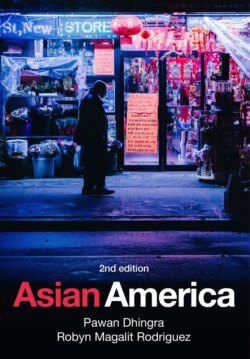Читать книгу Asian America - Pawan Dhingra - Страница 49
Gender and sexual constructions of the “yellow peril”
ОглавлениеThe “yellow peril” also poses a sexual threat. Asian-American men, much like black men, seek to “take” white women, either by seducing them with their mysterious powers or by raping them (Nguyen 2002). In either case, the purity of white women is in danger. Nor are Asian-American women considered more benign. In film and on stage, Asian-American women are often portrayed as conniving prostitutes, “dragon ladies,” or other temptresses whose true motivations are disguised as they try to seduce white men (Espiritu 2007; Shimizu 2007). In contrast, white women appear attractive but responsible. White men and women benefit from these sexualized stereotypes popular in media and everyday consciousness.
The aberrant sexuality of Asian Americans can cause the “yellow peril” to become a terrorist. Recent terrorizing episodes have been caused by “Orientals,” ranging from 9/11 Arab hijackers to the Korean-American murderer at Virginia Tech, Seung-hui Cho. These men have been framed as sexually repressed (Brandzel and Desai 2008). As befitting the “yellow peril” (or “brown” peril in the case of Arabs), their sexual frustration and deviance fuels their already unassimilable nature, which explodes in acts of violence. As Brandzel and Desai write of Cho:
This inability to achieve proper masculinity and heterosexuality may lead to dangerous excess, one that can threaten the object of its desire – namely, white women. Hence, the charges of stalking that were associated with Cho characterize him not only as deviant and inadequate but also as threatening. In this case, Asian American men can also be framed through a sexualized narrative of deviance, evoking the historical threat of the “yellow peril” ready to harm white femininity with contamination and miscegenation by the uncontrolled nonnormative sexuality of the Asian American men. (2008: 72)
In other words, Asian Americans threaten the security, economy, and morality of other Americans due to their foreign, untrustworthy, and morally inferior nature. This racial formation does not make them synonymous with blacks but instead as anti-American, in contrast to the prototypical Americans, who are presumably white. So, Asian-American racial inequality becomes framed as Asian American versus white, but does not map onto black–white relations directly.
